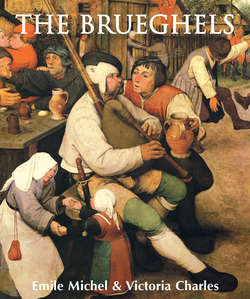The Brueghels

Реклама. ООО «ЛитРес», ИНН: 7719571260.
Оглавление
Victoria Charles. The Brueghels
Introduction
The Century of Pieter Bruegel the Elder
Pieter Bruegel the Elder’s Beginnings
Pieter Bruegel the Elder’s Mature Works
A Prosperous Dynasty
The Brueghel Family Tree
Bibliography
Отрывок из книги
Out of respect to the authors’ original work, this text has not been corrected or updated, particularly regarding attribution, dates, and the current locations of works. These were uncertain at the time of the text’s first publication, and sometimes remain so to this day. The information in the captions, however, has been updated.
Pen and brown ink, 25 × 21.6 cm.
.....
It became increasingly common for these painters to travel to Italy, and consequently their native impressions became mixed with those evoked by the lands through which they passed. Upon leaving the Flemish plains, the monotony of which is scarcely interrupted, the emigrant artists could not help but be struck by the imposing nature of the mountainous regions along their route. The Alps, the Tirols, and the Apennines offered the artists the rugged landscapes once sought by the Flemish Primitives, to whom simplicity had been of no interest. In their depiction of panoramas that stretched as far as the eye could see, these nomads remained faithful to their excessive preoccupation with the picturesque. They were of the belief that no amount of detail could be too much, and they tirelessly added bizarre rock formations and countless rivers to the harsh peaks and mountainous landscapes they painted. In addition, they laid out forests, towns, villages and castles that stretched into infinity. When, during their travels, they spent time in towns, at every step the Flemish painters encountered ancient ruins, monuments of various styles, statues, masterpieces by artists of the Classical age, and works of art no less admired by their less worthy successors; and everywhere they went they came across traditions and new ways of thinking vastly different from those they had known until then. How could they resist the seductions that solicited them from every direction? Their Italian colleagues, who were already organized in associations and guilds, welcomed the Flemish artists, affiliated them with their groups and initiated them into the wonders of the ars nova. On their return home, the travellers themselves often became apostles, extolling the principles of Italian painting and art in general, and attempting, though usually with little success, to imitate the Italian style.
In contrast to the strong unity that characterised the Flemish Primitives, these later artists of the Low Countries (who became known as the Romanists) allied themselves to a diverse range of qualities and trends that were frequently conflicting and often irreconcilable. In the treatment of landscapes, followers of academic doctrines, like the Brils and their imitators, aimed primarily for a decorative quality, which, in their somewhat awkward and affected compositions anticipated the noble expression and the poetic inspiration later found in the work of the two French artists Claude Gelée (known as le Lorrain) and Poussin. The Romanists were the only Flemish artists to work in the genre of historical painting, with its emphasis on large and detailed religious and mythological compositions. However, these works became increasingly rare because of the political difficulties that arose during the period: the princes and clergy of the Netherlands were too preoccupied with defending their under-appreciated power, and sometimes even their own existence, to be in a position to encourage painters of historical works.
.....